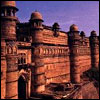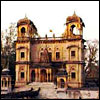|
|
|
|
|
|
|
|
|
|
|
|
|
| Area |
|
4,43, 466 sq kms. The Capital of this state is Bhopal |
|
| Boundaries |
|
To the East of Madhya Pradesh is the Bihar and Orissa,
to the North is Rajasthan and Uttar Pradesh, to
the West is Gujarat and to the South are Andhra
Pradesh and Maharashtra. |
|
| Important
Cities and towns |
|
Ambicapur, Videepa, Ujjain, Shiv Puri, Rahughar,
Raja Gruha, Guna, Gwalior, Bilaspur |
|
| Places
of Tourist Interest |
|
Khajuraho, Ujjain, Indore, Kanha, Sanchi.
|
|
| Best
Time To Visit |
|
April to May |
|
| Airports |
|
Bhopal, Gwalior, Indore, Bajalpur, and Khajuraho |
|
| Climate |
|
The states of Madhya Pradesh and Chattisgarh form
what is Central India. This region, more or less,
escapes very worst of summer season. However,
monsoons are very heavy here and cover the entire
period of July to September. In winter, temperature
falls during nights but days are sunny and pleasant.
|
|
| Required
Clothing |
|
Lightweights most of the year with warmer clothes
during evenings of winter.
|
|
| Food
culture |
|
The
mixed culture can be invariably seen in the typical
food habits ranging from South Indian 'Idli-Dosa'
, 'Vada-Sambhar' to 'Dal-Bafla' typical Malwa
Food.
Indore is known for its wide variety of "Namkeens''
, gujrati & chineese food restaurants , bengali
sweets. An
interesting research on Indorians has attributed
the large no.of heart disease, Hypertension patients
to their food habits. The life in Indore starts
early with chuskis of 'Chay' (tea) with 'garam
garam poha & Jalebi' followed by delicious
lunch which invariably includes popular 'besan
preparations'. Later in the day one can easily
find snacks like 'Khaman' , 'Kachori - aaloo kachori,
dal kachori etc.' , 'samosa' , 'petis' , 'Baked
Samosa' , 'Bhel puri' ,' Pani Puri', 'mathri'
etc. Numerous Shops of Sweets have enjoyed nice
business in Indore. Late nights another market
comes alive at 11:00 PM in Sarafa (the heart of
city) where one finds lot of delicacies to enjoy
after a nice dinner like - 'Gajak','Bhutta kis',
'Gulab Jamoon' , 'garadu', 'Rabri', 'HOT BOILED
MILK', 'aalo tikiya', 'Halua : - Gajar, Moong'
, icecreams, 'shakes' etc. and finally tasty 'paan'
to end your day.
INDORE
SPECIALITIES NOT TO BE MISSED :
Sweets
:Moong ka Halua, Gajar ka Halua, Rabri Gulab
Jamoon, Ras-Malai,RasGulla,All Bengali Sweets
available at Sarafa & 56 Shops at Palasia.
Namkeen
: Sev with all its varieties, Mixure , Dhania-Chivda,
Dal Moth,Papdi, Gathiya, Khaman, Kachori-Samosa
,Petis, Garadu,Aalo Tikiya, Pani-Puri, Bhel-Puri,Saboodana
Khijadi,Dahi Bada , Pakoda , Bhutte ka Kis.
'Sheetal
Pey' : Shikanji (Milk Preparation+Dry Fruits),
Lassi ,Cold Milk,Hot Boiled Milk with Malai
& dry fruits+keshar, Jal-Jira,Nimboo Shikanji,
Fruit Juice,Shakes, Icecream Soda, Santrola.
|
|
|
|
|
|
| GWALIOR |
|
A Living Heritage
of heroism: teeped in the splendour
of its past, the ancient capital of Gwalior
has yet made a successful transition into
a modern Indian city, vibrant and bustling.
A multitude of reigning dynasties, of
the great Rajput clans of the Pratiharas,
Kacchwahas and Tomars have left indelible
etchings of their rule in this city of
palaces, temples and monuments.
South
of the fort lies the main market area,
the Jayaji Chowk, which is the hub of
the new town. The main tourist attractions
are the archeological museum within the
Gujri Mahal Palace; The Mansingh Palace,
a delightfully whimsical building also
known as the Chit Mandir or painted Palace;
the Karan Palace; Sas-bahu temple and
Teli-Ka-Mandir. About 120 kms from Gwalior
lies the old summer capital of Shivpuri,
which is surrounded by a pleasant lake
and a beautiful garden.Excursions
include Datia and Orcha, well known for
their splendid temple architecture.
>>TOP
|
|
 |
|
|
|
|
|
|
 |
|
The city derives its name from the 18th
century Indreshwar temple. Situated in
the heart of the Malwa Plateau it was
the base of the Holkars, former rulers
of this erstwhile state. Indore, in fact,
was planned and built by Rani Ahilyabai
Holkar. Today, it is a throbbing, vibrant
city coloured by its brave past. It is
naturally endowed with a beautiful landscape
and salubrious climate. Of interest here
are numerous monuments associated with
the Holkars.
What
to See:
Rajwada:
Two hundred years ago, this seven storeyed
historical building formed the nerve centre
of all trading activities. Even today
it stands proud in the market place, a
silent tribute to the craftsmanship of
unknown artisans of centuries ago.
Kanch
Mandir:
The `Palace of Mirrors' is a quaint Jain
Shrine, close to Rajwada. The attraction
of this palace, as the name indicates,
is in the myriad mirrors studded on the
walls and the ceiling giving rise to multiple
reflections..
Lal
Baugh Palace:
Currently this is the residence of Usha
Raje, direct descendent of the Holkars,
whose ancestral palace it used to be.
Exquisitely constructed with great detailing,
it reflects the royal taste of the Holkars.
>>TOP
|
|
|
|
|
|
|
|
|
|




